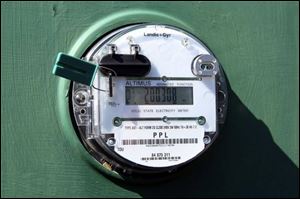
Electric utilities push savings through use of 'smart' meters
5/6/2008
A 'smart' meter tracks flow of electricity in real time.
ELIZABETHTOWN, Pa. - Determined to cut his electricity bill, Darrell Brubaker raised his air conditioner's thermostat and did more cooking on the grill.
But the key to maximum saving - as much as 6 percent a month last summer - was his grasp of the state of the electrical grid and his family's willingness to adjust their power use accordingly.
His utility, PPL Corp., is among a growing number of electricity providers that are testing plans in which rates are set higher during the hours of peak demand.
They use "smart" power meters that track how much electricity flows into a home in real time.
Mr. Brubaker, 56, has switched his lamps to energy-saving compact fluorescents and run his pool pump and dishwasher at night at his home in south central Pennsylvania.
"Essentially, it was just being more cognizant of, 'Yes there are more savings here if we do things differently,'•" Mr. Brubaker said.
By signing up tens of millions of people like Mr. Brubaker to change patterns of electricity consumption, utilities expect the new power meters and time-based rates to help prevent blackouts, curb greenhouse gas emissions, and delay construction of costly power plants.
Depending on its capabilities, a smart meter - at a cost of about $200 per home - also can play a role in how much information about energy use is made available to customers and how much money can be saved.
So far, pilot programs have found that the average customer usually saves money. Critics note, however, that's not always the case.
In a Commonwealth Edison Co. pilot program in Illinois, the average participant paid about 7 percent more in 2005, a departure from the pilot tests of other years. Company officials blamed the increase on spiking prices during an unusually hot summer and the disruption of natural gas supplies caused by Hurricane Katrina.
Last year, the utility said about 95 percent of participants saved money, with the majority saving between 7 to 12 percent. About 4,000 of the utility's 3.3 million residential customers have signed up.
Some consumer advocates remain skeptical. They warn that smart meters and fluctuating rates could be a multibillion-dollar mistake that would shift customers from the relative stability of an averaged, monthly rate and subject them to the unpredictable swings of the wholesale electricity market.